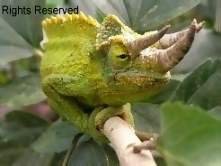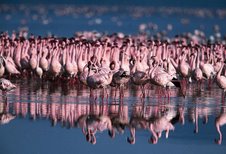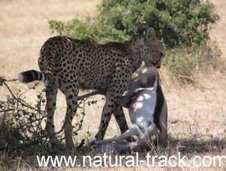Scientific Name: Phacochoerus aethiopicus
Size: 30 inches at the shoulder
Weight: 120 to 250 pounds
Swahili Name: Ngiri
They are found in most of Africa south of the Sahara and are widely distributed in East Africa. They are the only pigs able to live in areas without water for several months of the year. By tolerating a higher-than-normal body temperature, the warthog is perhaps able to conserve moisture inside its body that might otherwise be used for cooling.
Males weigh 20 to 50 pounds more than females, but both are distinguished by disproportionately large heads and the warts-thick protective-pads that appear on both sides of the head. The face is fairly flat and the snout elongated. Eyes set high on the head enables the warthog to keep a lookout for predators even when it lowers its head to feed on short grass.
The warthog's large tusks are unusual: The two upper ones emerge from the sides of the snout to form a semicircle; the lower tusks at the base of the uppers are worn to a sharp cutting edge. Two large pairs of warts occur below the eyes, and between the eyes and the tusks, and a very small pair is found near the jaw (usually just in males).
Sparse bristles cover the warthog's body, although longer bristles form a mane from the top of the head down the spine to the middle of the back. The warthog characteristically carries its tail upright when it runs, the tuft waving like a tiny flag. As the young run in single file, the tail position may serve as a signal to keep them all together.
Warthogs trot with a springy gait but they are known to run surprisingly fast. Warthogs live in family groups of a female and her young. Sometimes another female will join the group. Males normally live by themselves, only joining the groups to mate. Warthogs engage in ritual fights in which they charge straight on, clashing heads when they meet.
Fights between males can be violent and bloody. When water is available, warthogs drink regularly and enjoy wallowing in muddy places. As part of their grooming they also take sand baths, rub against trees and termite mounds and let tick birds pick insects off their bodies. Warthogs sleep and rest in holes, which at times they line with grass, perhaps to make them warmer.
Although they can excavate, warthogs normally do not dig holes but use those dug by other animals, preferably aardvarks. When water is available, warthogs drink regularly and enjoy wallowing in muddy places. As part of their grooming they also take sand baths, rub against trees and termite mounds and let tick birds pick insects off their bodies.
Before giving birth to a new litter, the female chases away the litter she has been raising and secludes herself. Female warthogs only have four teats, so litter sizes usually are confined to four young. Each piglet has its "own" teat and suckles exclusively from it. Even if one piglet dies, the others do not suckle from the available teat. Lions and leopards are the warthog's chief enemies.
Warthogs protect themselves from predators by fleeing or sliding backwards into a hole, thus being in a position to use their formidable tusks in an attack. When alarmed, the warthog grunts or snorts, lowers its mane, flattens its ears and bolts for underground cover. The warthog has poor vision (though better than most other African wild pigs), but its senses of smell and hearing are good.
PKP-kenia safari desk
Natural Track Safaris









No comments:
Post a Comment